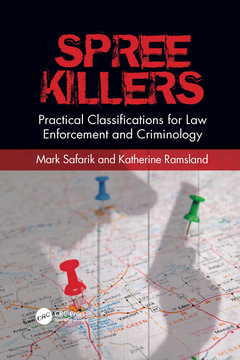Description
Spree Killers
Practical Classifications for Law Enforcement and Criminology
Language: English
Subjects for Spree Killers:
Keywords
Young Man; Barnegat Township; forensic science; Spree Killers; criminal profiling; Swat Team; behavioral profiling; Serial Subcategory; geographic profiling; Tight Locations; homicide; National Academy; serial homicide; FBI’s Behavioral Science Unit; serial murder; Spree Murders; serial killings; Mental Illness Category; serial killer; Swat; spree murder; Lone Operators; spree killing; Mission Category; signature killing; Thrill Killers; modus opperandi; sexual assault; Paranoid Schizophrenia; sexual violence; sadistic violence; Serial Murder Cases; domestic violence; Bible College Student; strangulation; Hate Ideology; ligature; Mobile Homes; ritual killing; Robbery Spree; FBI; Beth El; special victims unit; Investigative Support Unit; SVU; West Germany; Criminology; Law enforcement; Federal Bureau of Investigation
Publication date: 06-2021
· 15.6x23.4 cm · Paperback
Publication date: 11-2019
· 15.6x23.4 cm · Hardback
Description
/li>Contents
/li>Readership
/li>Biography
/li>
Spree Killers: Practical Classifications for Law Enforcement and Criminology is the only exhaustive, up-to-date analytical book on spree killers, standing apart from those dedicated to mass murderers and serial killers.
Multicides have traditionally been categorized as double, triple, mass, serial and spree?while, mass and serial have been further divided into subcategories. Spree killing, which involves the killing of at least three persons at two or more locations due to a precipitating incident that fuels the urge to kill, remains a poorly defined concept. In the United States, the Federal Bureau of Investigation (FBI) eliminated this term from its multicide nomenclature in 2005, but the authors examination of 359 cases involving 419 spree killers from 43 countries shows that not only is there enough diversity among spree killers to form classifications?similar to those devised for mass and serial?but also that subtypes offer distinct utility for identification, tracking, and warning potential targets.
Spree Killers outline the designation of spree killer specifically and thoroughly. In addition to looking at existing literature, specific cases, and the behavioral patterns, it offers a fully worked up profile for the typology. The behaviors and motives for spree killers align in six categories, which are detailed in full. The book provides unique insight for police, forensic, and investigative personnel into what to look for to respond to, and?in some cases identify and stopping?certain types of spree killings.
List of Figures
List of Tables
Foreword
Acknowledgments
About the Authors
1: Spree: A Muddled Concept
2: Anger and Revenge
3: On a Mission
4: Deadly Desperation
5: Mental Illness
6: Robbery and Thrill
7: Movement in Tight Locations
8: Mixed Multicides
9: Spree Analytics
10: Intended Spree
11: Unique Circumstances
12: Tips for Law Enforcement
Index
Dr. Katherine Ramsland, Ph.D., is a professor of forensic psychology at an assistant provost at DeSales University in Pennsylvania. She has published over 1,000 articles, stories, and reviews, and 65 books, including The Psychology of Death Investigation, Forensic Investigation: Methods from Experts, Confession of a Serial Killer: The Untold Story of Dennis Rader, the BTK Killer; The Mind of a Murderer; The Forensic Science of CSI; Inside the Minds of Serial Killers, and The Forensic Psychology of Criminal Minds. She presents workshops to law enforcement, psychologists, coroners, and attorneys, and has consulted for several television series, including The Alienist, CSI and Bones. She writes a regular blog for Psychology Today and has appeared in more than 100 crime documentaries.
Mark E. Safarik was a member of the Federal Bureau of Investigation’s elite Behavioral Analysis Unit. He established himself as an internationally recognized expert in the analysis of violent criminal behavior. Safarik’s law enforcement career spans over 30 years. He served 23 years with the FBI, the last 12, as a criminal profiler. He has lectured around the world, sharing his expertise in the analysis of homicide and complex crime scene behavior with over 20,000 personnel from police chiefs to violent crime investigators, prosecutors, medical examiners and other professionals. He currently consults with law enforcement, attorneys, universities, writers, television producers, and foreign government entities. Safarik has a graduate degree from Boston University and is adjunct faculty at Boston College. He has conducted internationally renowned research on the sexual assault and homicide of elder females and received the prestigious Jefferson Medal from the University of Virginia. He is a member of the highly respected Vidocq Society. He has published articles, and book chapters on his research and work. He has appeared on numerous




